Land Invertebrates
Media
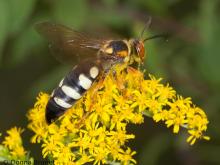
Species Types
Scientific Name
Stizus brevipennis
Description
The eastern stizus is a large, solitary wasp that is often misidentified as the better-known eastern cicada-killer wasp. The markings are slightly different, however, and the eastern stizus female hunts katydids, not cicadas.
Media
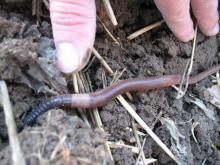
Species Types
Scientific Name
Amynthas and Metaphire spp.
Description
Jumping worms are invasive earthworms that are native to east Asia. They are spreading in North America and cause problems for plants and soils. They thrash violently when disturbed.
Media

Species Types
Scientific Name
About 1,300 species in North America north of Mexico
Description
The longlegged flies are a large, diverse fly family. They often have eye-catching metallic green, copper, bronze, or blue bodies and long legs. Their delicate wings are often clear and look iridescent in bright light, but many species have dark marks near the wing tips.
Media

Species Types
Scientific Name
8 tribes, with about 23 genera, in North America north of Mexico
Description
Millipedes in family Xystodesmidae often have bright colors that serve as a warning to potential predators that they may secrete foul or toxic substances.
Media

Species Types
Scientific Name
Conocephalus strictus
Description
The straight-lanced meadow katydid is common in pastures, roadsides, and crop lands. The female's swordlike ovipositor is longer than the rest of her body. The male's song is a relatively soft buzz that sometimes breaks into a series of rapid, skipping tics.
Media

Species Types
Scientific Name
Poecilopompilus algidus and P. interruptus
Description
Poecilopompilus spider wasps provision their nests with orbweaver spiders. They dig nest burrows into the ground and therefore prefer sandy or other workable substrates.
Media

Species Types
Scientific Name
Entypus aratus, E. unifasciatus, E. fulvicornis, and others
Description
Spider wasps in genus Entypus are bluish black and usually have some amount of amber color on their dark, smoky wings. Some species have bright yellow antennae.
Media
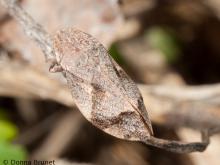
Species Types
Scientific Name
Lepyronia quadrangularis
Description
The diamondback spittlebug is common in weedy areas. The larvae live protected in spitty masses of foam. The adults are drab and well camouflaged, so few people notice them.
Media
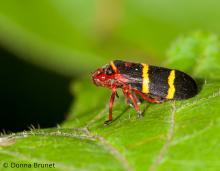
Species Types
Scientific Name
Prosapia bicincta
Description
The two-lined spittlebug is a common member of the froghopper family. The two lines may be red, orange, or yellow. Some individuals are all black, except for the red eyes.
Media
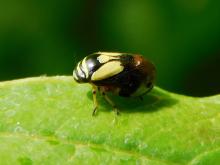
Species Types
Scientific Name
Clastoptera proteus
Description
The adult dogwood spittlebug has distinctive black and yellow markings. It feeds on dogwoods, blueberries, and their relatives.
See Also



Media

Species Types
Scientific Name
Cisseps fulvicollis
Description
The yellow-collared scape moth is more often “orange-collared.” And whether you think it looks more like a firefly or a wasp, it’s still a moth!
Media

Species Types
Scientific Name
Nearly 150 species in North America north of Mexico
Description
Slim, delicate plume moths are instantly recognizable by their T-shaped silhouette, long legs, and muted shades of tan and brown. It can be hard to separate the various species.
Media

Species Types
Scientific Name
Pyrrharctia isabella
Description
Not many people know the adult Isabella tiger moth when they see one, but we’re all acquainted with its caterpillar, the woolly worm, or woolly bear.
About Land Invertebrates in Missouri
Invertebrates are animals without backbones, including earthworms, slugs, snails, and arthropods. Arthropods—invertebrates with “jointed legs” — are a group of invertebrates that includes crayfish, shrimp, millipedes, centipedes, mites, spiders, and insects. There may be as many as 10 million species of insects alive on earth today, and they probably constitute more than 90 percent all animal species.





















